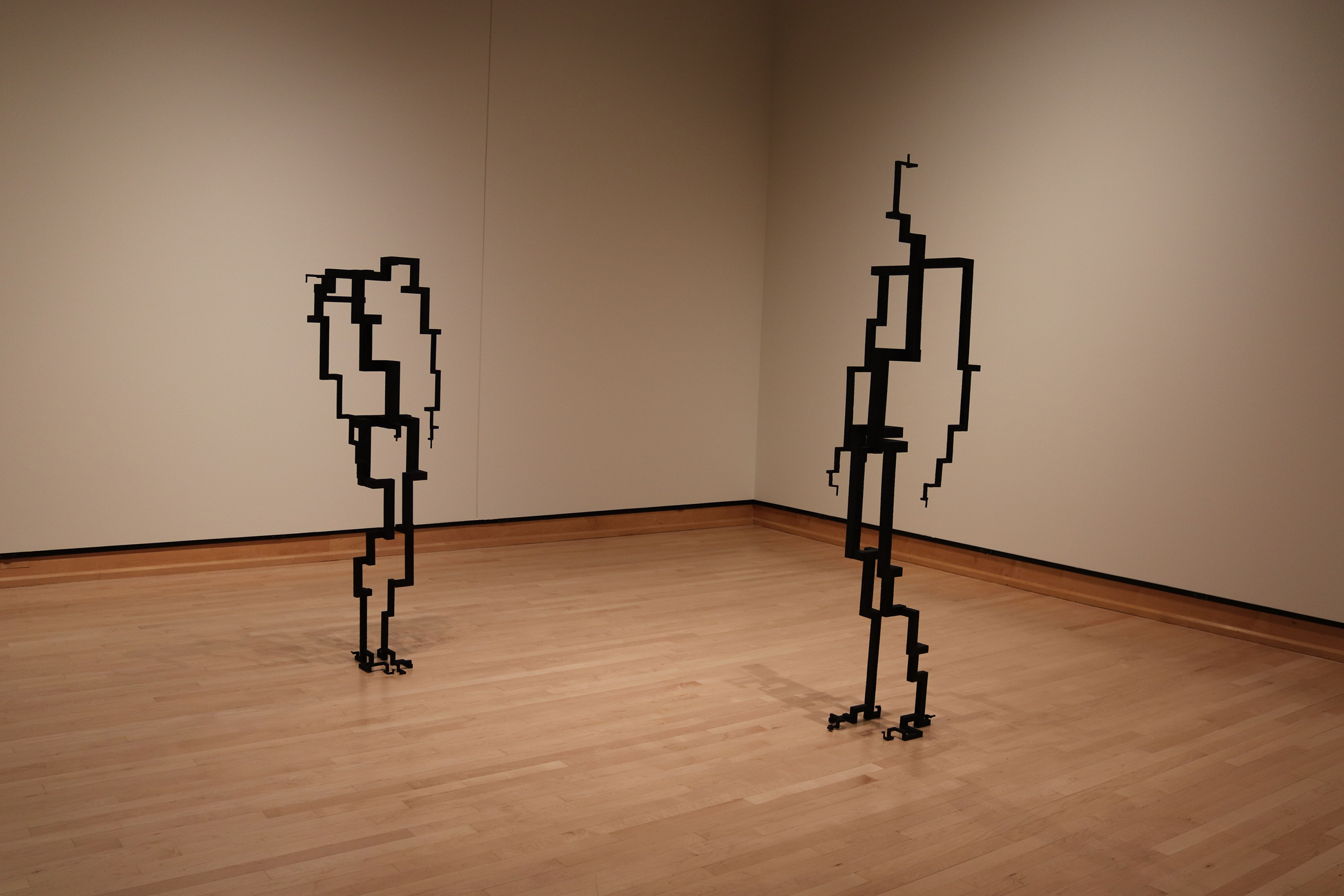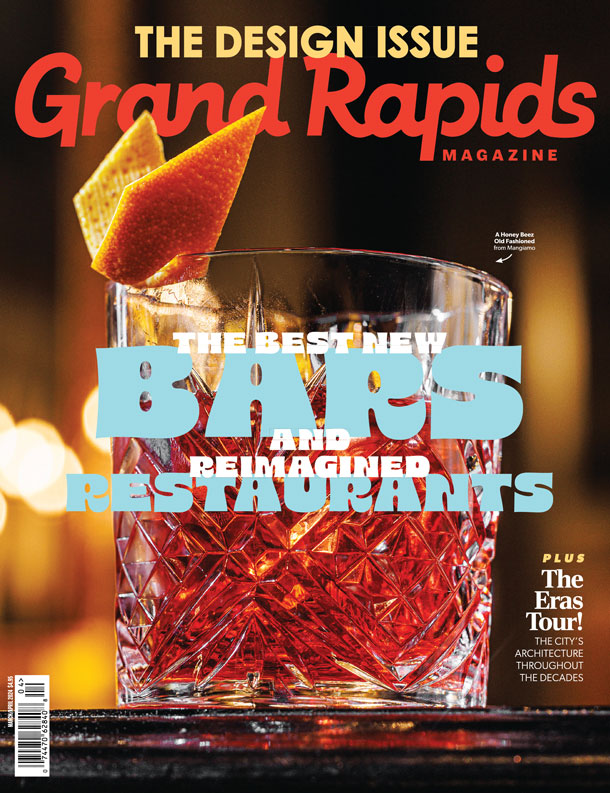This year, Fred Meijer would have been 100 years old. Next year, Frederik Meijer Gardens & Sculpture Park will turn 25. They’re in the middle of a huge expansion project, continuing to grow from an idea to have a little garden behind a new Meijer Thrifty Acres on the Beltline. The new exhibition at Meijer Gardens — which opened this weekend — tells the story of a legacy built over time.
I like to picture this all starting, though, at the kitchen table. Fred and Lena are talking about their growing grocery empire, from what began with Fred opening a single grocery store with his dad, in the middle of the Great Depression of all times. They’re sitting there over a second cup of coffee, figuring out how they can give back to their community by sharing some of the things they love. Lena was a horticulture fan, and wanted a garden for the community. Fred had started collecting sculptures and loved getting to know artists. He was stuck on traditional formal work at the time, representational figures and animals in particular.
But over time, Lena’s garden turned into a stellar horticultural marvel, and Fred’s openness to modern and contemporary art and his love of talking to artists, along with his recognition of needing professionals to help him grow — all made it possible for him to amass a sculpture collection that is one of the best in the country, no hyperbole. The just-opened indoor gallery exhibition, “A National Treasure: Fred Meijer, His Collection and Legacy,” celebrates just how far Meijer Gardens has come.
The gallery itself is full of the biggest names in sculpture today and yesterday. It’s shocking, really: Auguste Rodin to Ai Weiwei, Alexander Calder to Anish Kapoor, Marshall Fredericks to Deborah Butterfield. I often call the outdoor sculpture park “a walk through my art history books,” and this new exhibit creates that same feeling within the indoors, a walk through an art history book and a chance to see new work by artists you’ve seen while walking through the gardens in warmer months.
Maybe 70-75 percent of the exhibition’s artwork is part of the permanent collection, and the rest is on loan, from artists and their galleries often. These works give us a chance to see the current work of those we might have seen in the gardens, giving us a chance to see how an artist grows their work over time.
 Anish Kapoor is a great example. You may know him more broadly for “the bean” in Chicago, actually titled “Cloud Gate.” Or perhaps you have noticed his “Untitled” piece in the Japanese Garden at Meijer Gardens. But hanging, somewhat impossibly it looks, on the wall in the gallery is this pristine, serene sculpture. This gargantuan floating silver bowl is lined on the inside with a smooth, matte deep violet, almost eggplant, glow. It may not be Instagramable like the bean, but it definitely does make us stop, slow down and inspect more closely. If we’re paying attention to our bodily reaction, we’ll see our breathing has slowed, evidence of the power of contemplation created by this minimalist piece.
Anish Kapoor is a great example. You may know him more broadly for “the bean” in Chicago, actually titled “Cloud Gate.” Or perhaps you have noticed his “Untitled” piece in the Japanese Garden at Meijer Gardens. But hanging, somewhat impossibly it looks, on the wall in the gallery is this pristine, serene sculpture. This gargantuan floating silver bowl is lined on the inside with a smooth, matte deep violet, almost eggplant, glow. It may not be Instagramable like the bean, but it definitely does make us stop, slow down and inspect more closely. If we’re paying attention to our bodily reaction, we’ll see our breathing has slowed, evidence of the power of contemplation created by this minimalist piece.
The galleries walk the viewer through Fred’s own progression of art appreciation, with animal and figurative work in the first rooms, through to more modern pieces as you move to the back room, where you pass a wood sculpture by Ai Weiwei to meet one of the newest acquisitions, first shown in this exhibition, “New World Map” by El Anatsui, a highly sought after artist for all major collectors today.
After taking in the exhibit myself, I got a chance to walk through and learn more from Laurene Grunwald, the director of sculpture exhibitions, who’s been at Meijer Gardens for much of the growth herself. As we discuss the work in front of us and Fred Meijer’s progression in art appreciation, she apologizes for the stanchions in front of some of the work (You know those little metal cords to keep you from getting too close? Bane of my existence, though I understand the need for them.).
“The butterflies are coming,” she explains. The tropical conservatory, just beyond the indoor gallery, is about to be filled with thousands upon thousands of butterflies from around the world, my yearly bit of hope for making it through winter. And with those butterflies come thousands upon thousands of toddlers, curious and not so careful.
I laugh and tell her the stanchions are important for people like me too, with my experience in galleries and museums and art education. I confess that I’m usually the one who runs into a stanchion unawares, not realizing I was getting too close with my own curiosity. And to me, the need for protective measures is a testament to the ability to make art spaces that are welcoming and approachable.
This is the beauty of Fred and Lena marrying their love for plants and art to give them back to the community: They’ve created a welcoming space, an honest high purpose for the whole “gathering place” trend that is so prevalent. But they started where everything authentic does — before it became trendy.
People may come for those butterflies or the Christmas tree display or the concerts. But they bump into beautifully curated high art, including modern and contemporary art they’re not familiar with, along the way. The lush variety of natural settings outdoors and the stunning colors on the walls indoors, along with so many other curatorial decisions, make us stop and look, to slow down and appreciate something new. Every time.
 I continue my walk with Grunwald, as we venture into the Victorian conservatory and the tropical conservatory, where the exhibition continues beyond the gallery space, and we talk about this incredible legacy.
I continue my walk with Grunwald, as we venture into the Victorian conservatory and the tropical conservatory, where the exhibition continues beyond the gallery space, and we talk about this incredible legacy.
“No one, I think, envisioned how quickly and how extensively Meijer Gardens would grow,” she says. “Things grew and evolved, and it was definitely motivated by where we could take it, and what could happen next — we call it ‘The Fred Factor.’”
But Grunwald is also quick to recognize that though that excitement of The Fred Factor may have sparked things to get going, it took a whole community to make it happen.
“They were certainly the driving force and the namesake, and we’d never be here without them,” she explains. “But we have so many people in our community that support us and give to us. It’s been an amazing thing.”
So go, enjoy the Meijer legacy, read the placards to learn more of the story, but remember that this is a community legacy. And though Fred Meijer may be gone, it is our job to keep community assets in the arts going, for all of us to enjoy.
“A National Treasure: Fred Meijer, His Collection and Legacy”
Feb. 1 to Aug. 25
Frederik Meijer Gardens & Sculpture Park
Photos: Courtesy Frederik Meijer Gardens & Sculpture Park








Facebook Comments